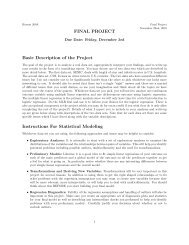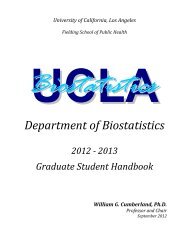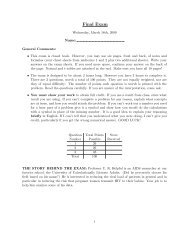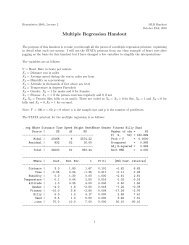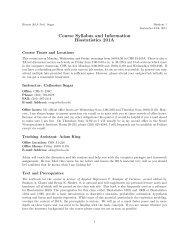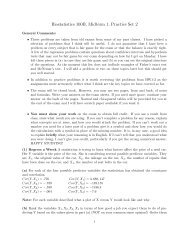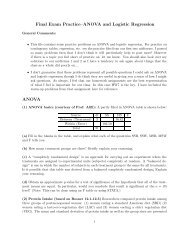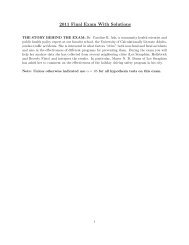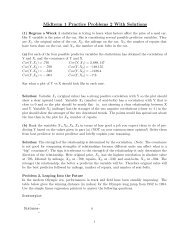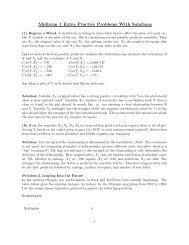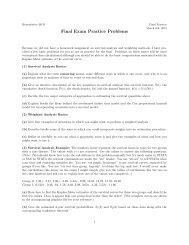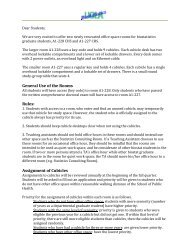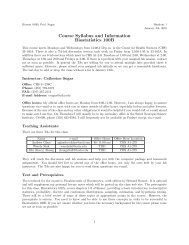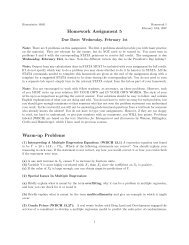Solutions to the practice problems. - UCLA Biostatistics
Solutions to the practice problems. - UCLA Biostatistics
Solutions to the practice problems. - UCLA Biostatistics
Create successful ePaper yourself
Turn your PDF publications into a flip-book with our unique Google optimized e-Paper software.
(e) The prin<strong>to</strong>ut below shows <strong>the</strong> log-rank test comparing <strong>the</strong>se two groups. Explain what hypo<strong>the</strong>ses are<br />
being tested and give your real-world conclusions.<br />
Solution: The log rank test tests whe<strong>the</strong>r <strong>the</strong> hazards rates for <strong>the</strong> two groups are <strong>the</strong> same over a given<br />
interval (generally up <strong>to</strong> <strong>the</strong> time of <strong>the</strong> last observed event which for us occurred at 28.65 years. The<br />
hypo<strong>the</strong>ses are <strong>the</strong>refore:<br />
H 0 : h 0 (t) = h 1 (t) for all t ≤ 28.65–<strong>the</strong> two groups have <strong>the</strong> same hazard function (or equivalently survival<br />
function, distribution of survival times, etc.) over <strong>the</strong> period covered by our study.<br />
H A : For at least some t, h 0 (t) ≠ h 1 (t)–<strong>the</strong> two hazard functions, survival curves, etc. are not identical.<br />
From <strong>the</strong> prin<strong>to</strong>ut we see that <strong>the</strong> p-value for <strong>the</strong> test is .0189 which is less than our usual significance level<br />
of α = .05 so we reject <strong>the</strong> null hypo<strong>the</strong>sis and conclude that <strong>the</strong>re is a difference in <strong>the</strong> hazard functions,<br />
at least over some part of <strong>the</strong> 0-30 year time interval. Given what we have seen in <strong>the</strong> K-M plot of <strong>the</strong> two<br />
survival curves this isn’t <strong>to</strong>o surprising–<strong>the</strong> curves look very different. The reason our results have been so<br />
close is that our sample is very small.<br />
Log-rank test for equality of survivor functions<br />
| Events Events<br />
group | observed expected<br />
------+-------------------------<br />
0 | 7 10.47<br />
1 | 7 3.53<br />
------+-------------------------<br />
Total | 14 14.00<br />
chi2(1) = 5.51<br />
Pr>chi2 = 0.0189<br />
(f) Suppose none of <strong>the</strong> observations had been censored. What would your estimates of <strong>the</strong> 3-year survival<br />
probabilities have been and why<br />
Solution: If <strong>the</strong>re is no censoring <strong>the</strong>n <strong>the</strong> Kaplan-Meier estimate of <strong>the</strong> survival curve is simply <strong>the</strong><br />
proportion of people who have survived up <strong>to</strong> that time. For 3-year survival if all our observations were<br />
uncensored we’d have ˆp 0 = 7/10 = .7 surviving in group 0 and ˆp 1 = 5/19 = .5 surviving in group 1.<br />
6



